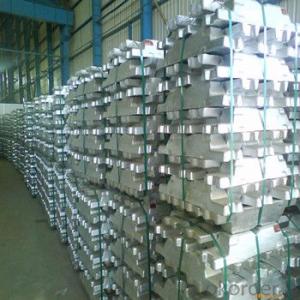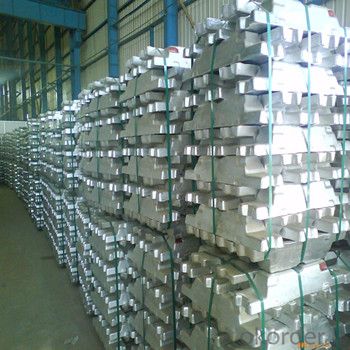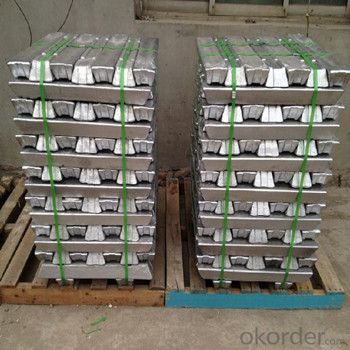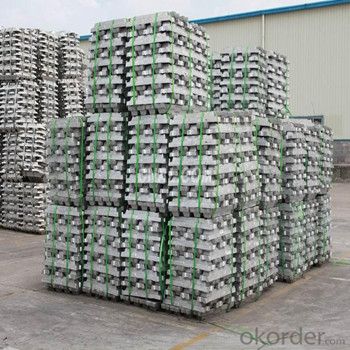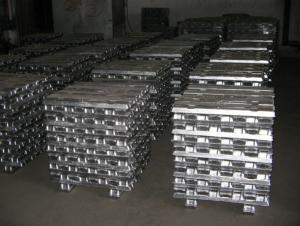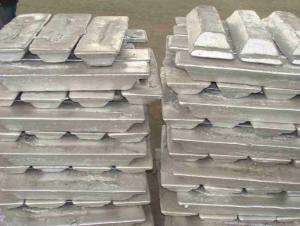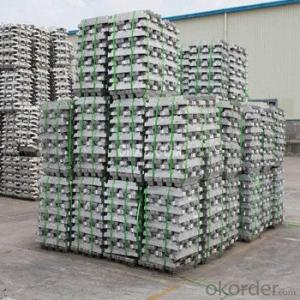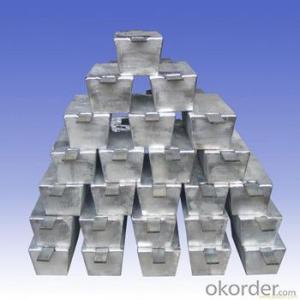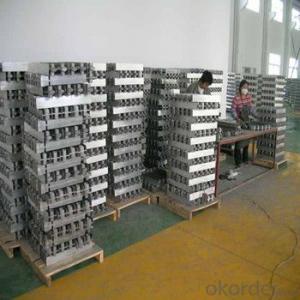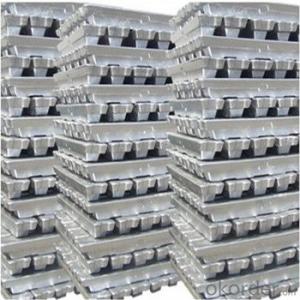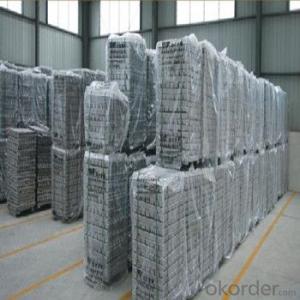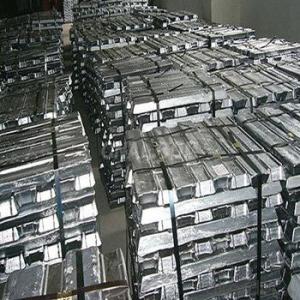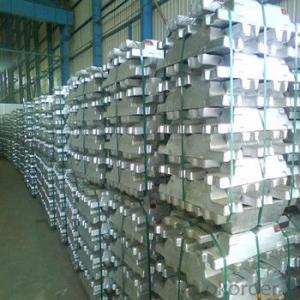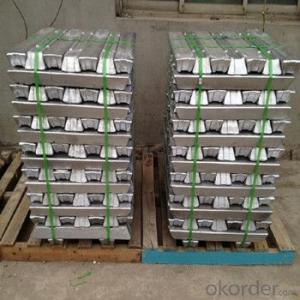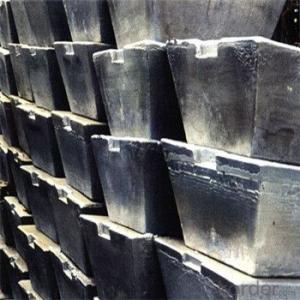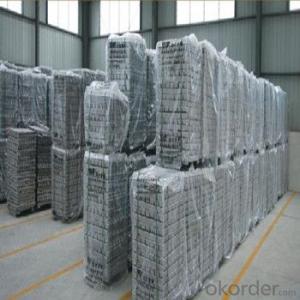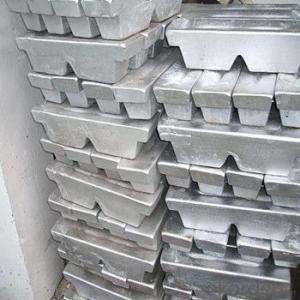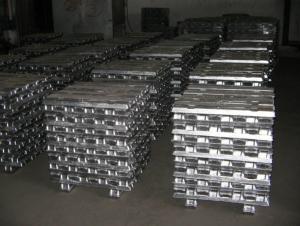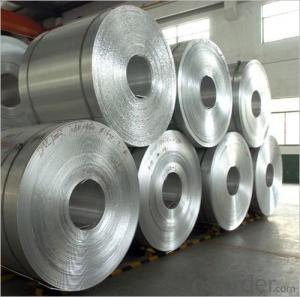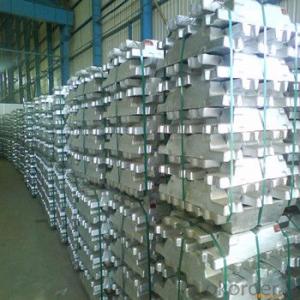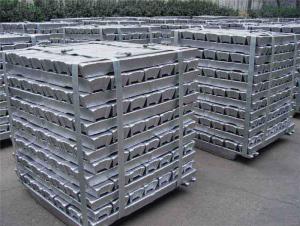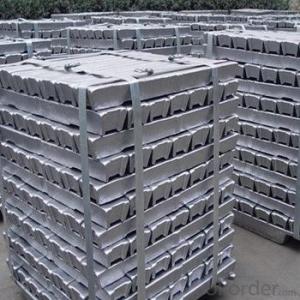Aluminium Ingot from Factory and Best Seller
- Loading Port:
- China main port
- Payment Terms:
- TT OR LC
- Min Order Qty:
- 1000 m.t.
- Supply Capability:
- 10000 m.t./month
OKorder Service Pledge
OKorder Financial Service
You Might Also Like
Pure Aluminum Ingot Used for Industry
1.Structure of Aluminum Ingot Description
Aluminum Ingot is with the AL as the main chemical composition. Aluminum Ingot is used for industry,such as automobile,pinning and weaving,electron broadly and so on. Aluminum Ingot has the following advantages: easy control and operation, fast melting.
2.Main Features of the Aluminum Ingot
•High Purity
•Easy control and operation
•High strength
•Fast melting
•Competitive price
•Best Service
3. Aluminum Ingot Images
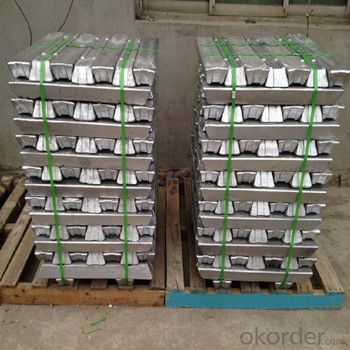
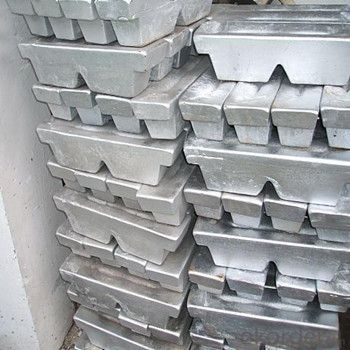
4. Aluminum Ingot Specification
Grade | Chemical Composition % | |||||||||
Al≥ | impurities ≤ | |||||||||
Si | Fe | Cu | Ga | Mg | Zn | Mn | others | Sum | ||
Al99.9 | 99.90 | 0.50 | 0.07 | 0.005 | 0.02 | 0.01 | 0.025 | - | 0.010 | 0.10 |
Al99.85 | 99.85 | 0.80 | 0.12 | 0.005 | 0.03 | 0.02 | 0.030 | - | 0.015 | 0.15 |
Al99.7 | 99.70 | 0.10 | 0.20 | 0.010 | 0.03 | 0.02 | 0.030 | - | 0.030 | 0.30 |
Al99.6 | 99.60 | 0.16 | 0.25 | 0.010 | 0.03 | 0.03 | 0.030 | - | 0.030 | 0.40 |
Al99.5 | 99.50 | 0.22 | 0.30 | 0.020 | 0.03 | 0.05 | 0.050 | - | 0.030 | 0.50 |
Al99.00 | 99.00 | 0.42 | 0.50 | 0.020 | 0.03 | 0.05 | 0.050 | - | 0.050 | 1.00 |
5.FAQ of Aluminum Ingot
We have organized several common questions for our clients,may help you sincerely:
①How about your company?
A world class manufacturer & supplier of castings forging in carbon steel and alloy steel,is one of the large-scale professional investment casting production bases in China,consisting of both casting foundry forging and machining factory. Annually more than 8000 tons Precision casting and forging parts are exported to markets in Europe,America and Japan. OEM casting and forging service available according to customer’s requirements.
②How to guarantee the quality of the products?
We have established the international advanced quality management system,every link from raw material to final product we have strict quality test;We resolutely put an end to unqualified products flowing into the market. At the same time, we will provide necessary follow-up service assurance.
③How long can we receive the product after purchase?
In the purchase of product within three working days, We will arrange the factory delivery as soon as possible. The pecific time of receiving is related to the state and position of customers.Commonly 7 to 10 working days can be served.
- Q: What are the different surface treatment options for aluminum ingots?
- There are several surface treatment options available for aluminum ingots, depending on the desired outcome and application. Some of the commonly used surface treatment options for aluminum ingots include anodizing, powder coating, polishing, and painting. Anodizing is a popular surface treatment method for aluminum ingots. It involves creating a protective oxide layer on the surface of the aluminum through an electrochemical process. Anodizing provides various benefits such as increased corrosion resistance, improved durability, and enhanced aesthetic appearance. It also allows for coloring options by dyeing the oxide layer. Powder coating is another surface treatment option for aluminum ingots. It involves applying a dry powder coating to the surface of the aluminum and then curing it in an oven. The powder adheres to the surface electrostatically and creates a durable and protective layer. Powder coating offers excellent resistance to impacts, chemicals, and weather conditions. It is available in a wide range of colors and finishes. Polishing is a surface treatment method that involves smoothing and shining the surface of aluminum ingots. It is achieved by using abrasive materials and techniques to remove any imperfections, scratches, or dullness. Polishing enhances the aesthetic appearance of aluminum, giving it a mirror-like or satin finish. Painting is a surface treatment option that involves applying a liquid paint coating to the surface of aluminum ingots. It can provide both protection and decoration. Painting allows for a wide range of colors and finishes, providing flexibility in design and customization. It is commonly used for architectural applications, outdoor furniture, and automotive parts. In addition to these surface treatment options, aluminum ingots can also undergo other treatments like brushing, sandblasting, and etching. These methods can offer unique finishes and textures to the aluminum surface, depending on the specific requirements of the application. Overall, the choice of surface treatment for aluminum ingots depends on factors such as the desired appearance, functionality, and the environment in which the aluminum will be used. Each treatment option has its own advantages and considerations, so it is essential to carefully evaluate the requirements before selecting the most appropriate surface treatment method.
- Q: Now refining aluminum ingot profits? What are the main factories?
- In general, the main customers are made of raw materials for the recycled aluminum plant. The price depends mainly on the composition and physical quality. This equipment is like a house to buy equipment and then to their masonry, generally dug a hole 2 meters deep, the pot material has 2 kinds, one kind is graphite, a cast iron, graphite is relatively better, Zhejiang has Yongkang sell, including tools, and this process is originated in the then, if you want to do better to the study, to be able to please the master.
- Q: Can aluminum ingots be used in the production of musical instruments?
- Musical instruments can indeed be produced using aluminum ingots. Aluminum, a lightweight and adaptable metal, possesses various characteristics that render it suitable for musical instruments. Its malleability and ease of manipulation enable the crafting of intricate designs and intricate components. Moreover, aluminum's resistance to corrosion aids in preserving the instrument's quality and lifespan. Furthermore, aluminum boasts excellent resonant properties, resulting in the production of crisp and lively sound. To enhance performance and durability, numerous instruments like trumpets, flutes, and saxophones incorporate aluminum in their construction.
- Q: What are the different alloying elements used in aluminum ingots?
- There are several different alloying elements that can be used in aluminum ingots to enhance various properties and characteristics of the metal. Some of the commonly used alloying elements include: 1. Copper (Cu): Copper is often added to aluminum ingots to increase the strength and hardness of the alloy. Copper-aluminum alloys, also known as aluminum bronzes, have excellent corrosion resistance and are widely used in marine applications. 2. Zinc (Zn): Zinc is commonly used as an alloying element in aluminum ingots to improve the castability of the metal. Aluminum-zinc alloys, such as the 7000 series, have high strength, good corrosion resistance, and are often used in aerospace and automotive applications. 3. Magnesium (Mg): Magnesium is a widely used alloying element in aluminum ingots, especially in the 5000 series alloys. It improves the strength and machinability of the aluminum and provides good corrosion resistance. Aluminum-magnesium alloys are commonly used in structural applications. 4. Silicon (Si): Silicon is added to aluminum ingots to improve their casting characteristics and reduce shrinkage during solidification. Aluminum-silicon alloys, such as the 4000 series, have good fluidity and are often used in automotive and electronic components. 5. Manganese (Mn): Manganese is used as an alloying element in aluminum ingots to increase strength and improve corrosion resistance. Aluminum-manganese alloys, such as the 3000 series, have good formability and are commonly used in construction and packaging industries. 6. Chromium (Cr): Chromium is added to aluminum ingots to improve their heat resistance and enhance their mechanical properties. Aluminum-chromium alloys, such as the 2000 series, are often used in aerospace and high-temperature applications. 7. Lithium (Li): Lithium is a lightweight and highly reactive element that is used in small amounts to create high-strength, low-density aluminum-lithium alloys. These alloys are primarily used in aerospace applications where weight reduction is critical. These are just some of the alloying elements used in aluminum ingots. The choice of alloying elements depends on the desired properties of the final product and the intended application.
- Q: What kinds of aluminum alloy material are used in casting?
- Aluminum and aluminum as common screen etc.. It is used extrusion process, that is, aluminum ingots and other raw materials in the melting furnace, after extrusion extruder extrusion die molding, it can also extrude a variety of profiles of different sections. The main properties, namely strength, hardness and wear resistance, are in accordance with the national standard GB6063. The utility model has the advantages of light weight, only 2.8, no rust, fast design change, low die input and longitudinal elongation up to more than 10 meters. There is light, matte of aluminum appearance, the process of anodic oxidation treatment, surface treatment of oxide film thickness reaches 0.12m/m. The thickness of aluminium section according to product design optimization choice, the market is not as thick as possible, should look at the section structure requirements of the design, it can not in 0.5~5mm. Layman thinks that the thicker and tougher, it is the wrong view.
- Q: How are aluminum ingots used in the automotive industry?
- Aluminum ingots play a crucial role in the automotive industry as they are widely used for manufacturing various components of vehicles. One of the primary applications of aluminum ingots is in the production of engine blocks. The lightweight nature of aluminum makes it an ideal material for engine blocks, as it helps to reduce the overall weight of the vehicle, thereby improving fuel efficiency and performance. Additionally, aluminum ingots are used in the manufacturing of wheels, transmission cases, cylinder heads, and other critical parts of the automobile. The high strength-to-weight ratio of aluminum makes it a preferred choice for these components, as it ensures durability and enhances the overall safety of the vehicle. Moreover, aluminum ingots are utilized in the construction of car body panels, such as hoods, doors, and trunk lids. Aluminum body panels offer significant weight reduction compared to traditional steel panels, leading to improved energy efficiency and handling. Furthermore, aluminum has excellent corrosion resistance properties, which helps to enhance the longevity of these body panels. In recent years, with the growing demand for electric vehicles (EVs), aluminum ingots have gained even more prominence in the automotive industry. EVs require lightweight materials to compensate for the heavy battery packs, and aluminum ingots provide the perfect solution. The use of aluminum in EVs not only helps to increase driving range but also improves battery life and enhances overall performance. In conclusion, aluminum ingots are extensively used in the automotive industry for their lightweight nature, strength, and corrosion resistance properties. They are vital components in engine blocks, transmission cases, wheels, body panels, and other critical parts, contributing to improved fuel efficiency, safety, and performance of vehicles.
- Q: How to calculate the price with or without ticket in the aluminum ingot trade? Does the invoice price increase with aluminum?
- The difference between the price of the ticket and the price without the ticket is between the price of the ticket and the price of the ticket without the price of the ticket.
- Q: How are aluminum ingots used in the production of heat sinks?
- Aluminum ingots play a crucial role in the production of heat sinks. Heat sinks are used to dissipate heat generated by electronic devices such as computers, smartphones, and LED lights. Aluminum is an ideal material for heat sinks due to its excellent thermal conductivity, lightweight nature, and cost-effectiveness. The process begins with aluminum ingots being melted down and cast into the desired shape and size of the heat sink. The ingots are heated to their melting point, typically around 660 degrees Celsius, and then poured into molds to form the initial shape of the heat sink. Once the heat sink shape is formed, it undergoes various machining processes such as milling, drilling, and cutting to create the necessary fins and surface area for efficient heat dissipation. These processes help increase the surface area of the heat sink, allowing for better air circulation and heat transfer. After the initial shaping and machining, the heat sink is often treated with various surface finishes or coatings to enhance its thermal properties and protect it from corrosion. These finishes may include anodizing, which creates a protective oxide layer on the surface, or electroplating, which improves the heat sink's appearance and durability. Once the heat sink is manufactured, it is typically attached to the electronic device using thermal interface materials such as thermal paste or pads. These materials help maximize the contact between the heat sink and the electronic component, ensuring efficient heat transfer. Overall, aluminum ingots are an essential component in the production of heat sinks. They provide the necessary material for creating heat sinks with excellent thermal conductivity, lightweight design, and cost-effectiveness. The use of aluminum ingots in heat sink production helps enhance the performance and reliability of electronic devices by effectively dissipating heat and preventing overheating.
- Q: What aluminum factories are there in Guangdong and Foshan?
- I suggest to use tide abundant aluminium material, electrophoresis material price is in same grade calculate cheap, aluminous ingot valence adds electrophoresis to process cost 4900-5000 yuan, every tons or so.
- Q: Can aluminum ingots be used in the production of jewelry?
- Indeed, the application of aluminum ingots in the production of jewelry is possible. Aluminum, being a versatile metal, lends itself easily to the molding and shaping required for various jewelry designs. With its lightweight nature, it ensures a comfortable wearing experience, while its inherent silver-like appearance can be further magnified through diverse surface finishes, including polishing or anodizing. Moreover, its hypoallergenic properties render it an appropriate choice for those individuals with sensitive skin. Although aluminum may not possess the same value as precious metals like gold or silver, it presents a more economical alternative for crafting jewelry and can be combined with other materials to yield distinctive and fashionable pieces.
Send your message to us
Aluminium Ingot from Factory and Best Seller
- Loading Port:
- China main port
- Payment Terms:
- TT OR LC
- Min Order Qty:
- 1000 m.t.
- Supply Capability:
- 10000 m.t./month
OKorder Service Pledge
OKorder Financial Service
Similar products
Hot products
Hot Searches
Related keywords
